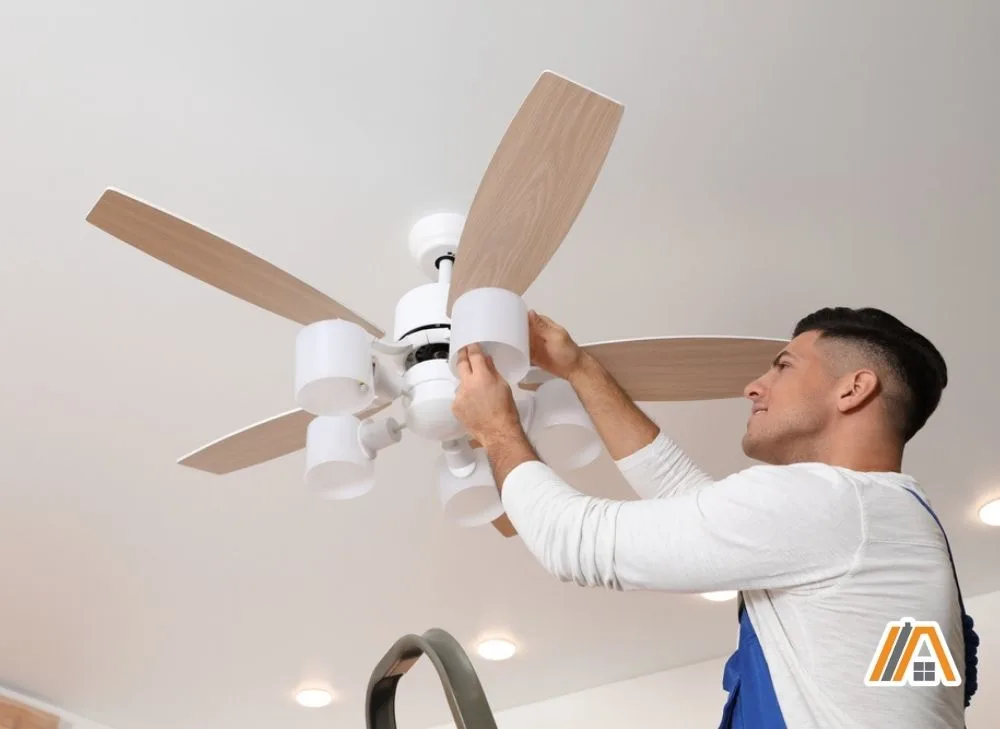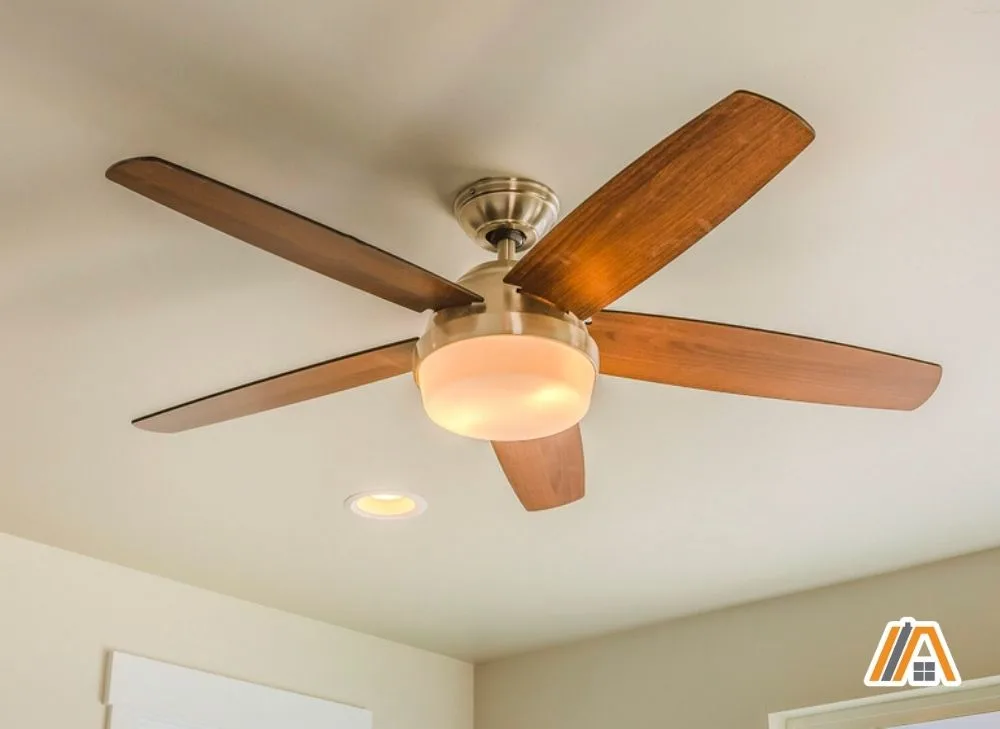It’s fun to plan home improvement projects. But often, shopping for the items necessary turns out to be very stressful, since there are too many different colors, sizes, materials, styles to choose from.
Choosing the right fan can be quite challenging, and if you haven’t done the homework before, you might end up with a product that is unsuitable for you.
We will make one thing clear; how many blades you will need on your ceiling fan.
Now let’s take a deep breath and go through all the reasons why the number of blades matters. At the end of this article, you will know exactly how many blades you want for your ceiling fan.

The number of ceiling fan blades is important, especially if you are looking for a ceiling fan for your home environment. The number of blades will play a huge role in how quiet the ceiling fan is, how much air it can move, how well it will be balanced, how energy efficient it is, and how the air movement will feel when you are near the fan.
Does The Number of Blades Change The Ceiling Fan Noise Level?
Have you ever noticed that all the big industrial fans have no more than 3 blades? Actually, 3 blades are the most common. And they move massive amounts of air, but that comes at a cost. It’s the increased noise level that comes with it.
A Ceiling fan with 3 blades must spin much faster to achieve the same airflow compared to fans with more blades. This is why they are noisier.
If your goal is to buy a quiet ceiling fan, then the more blades the ceiling fan has the quieter it will be.
There is no info about the noise level on ceiling fan product sheets. The only info about noise level is that they are “silent”. It is very hard to compare how the number of blades affects noise level if they all say it’s “Silent” 🙂
But this way you can get some idea how loud it can be, especially if you already have a ceiling fan at home. Then you have the possibility to compare it to the noise level of your current fan.
In the table, we have compared ceiling fans with similar CFM values. This is also something that you can do when you are deciding between different ceiling fans and can’t decide which one to buy.
Find the specs for the ceiling fan and simply divide the RPMs by the CFM’s to get how many revolutions the fan will spin in order to move 1 cubic feet of air. Generally, the faster the fan will spin, the louder it will be
Choose the fan with the smallest RPM-per-CFM value. Then you will end up with a quieter ceiling fan.
RPM/CFM = RPM-per-CFM.
| Number of blades | RPM(Revolutions-per-minute) | CFM(Cubic-feet-per-minute) | RPM- per-CFM |
| 2 | 4950 | 183 | 0.037 |
| 3 | 5600 | 182 | 0.032 |
| 4 | 4700 | 160 | 0.034 |
| 5 | 6000 | 170 | 0.028 |
| 6 | 5800 | 156 | 0.026 |
Does The Number of Blades Change Ceiling Fan Airflow Efficiency
You might think that a 6 blade fan will have better airflow efficiency than a 2 blade fan. But it is not true. Having more blades does not always mean better airflow efficiency.
A ceiling fan with fewer blades will have less air resistance from the rotation of the blades, thanks to this it will be easier for the motor to spin the blades, and therefore it will be more efficient.
Also, ceiling fans with more than 4 blades will do an excellent job and they have no problem moving the air. But they use slightly more energy to do so, because of the drag on the motor.
More blades means more air resistance and more work to the motor to rotate the blades. This can also increase running costs.
Here is a table where we see how the number of blades affects airflow efficiency.
| Number of Blades | Air flow CFM | Wattage | Airflow efficiency Cfm/Watt (The larger the better) |
| 1 | 5800 | 50 | 114 |
| 2 | 6700 | 32 | 207 |
| 3 | 6700 | 27 | 248 |
| 4 | 6800 | 30 | 225 |
| 5 | 6800 | 31 | 221 |
| 6 | 6600 | 33 | 200 |
In the table, it is really clear to see that the 3 blade ceiling fan is the most efficient out of the bunch. That is why it is commonly used in factories and greenhouses.
If you are not looking for a ceiling fan for your bedroom, and don’t mind the extra noise that comes with it, a 3 blade ceiling fan is a good energy-efficient option.
Does The Number Of Blades Affect Ceiling Fan Balance
A balanced ceiling fan is really important because if it is not balanced it will start to wobble and will be annoying. Furthermore, the vibrations can negatively impact the light bulbs (if the ceiling fan is a combination unit), especially LED light bulbs.

A ceiling fan with more blades might be extra tricky to get balanced if needed. Because every blade needs to be inspected when you are trying to figure out which one is the faulty one.
Sure, ceiling fans with only one blade are made for everyday use, but still, they will be louder and trickier to get back to balance if it’s out of balance.
While there are also other things that need to be in balance in addition to ceiling fan blades and blade holders, it all starts from the manufacturer. More expensive ceiling fans have higher quality components and they will be more balanced overall.
Does The Number Of Blades Affect Comfort
When we look into ceiling fan blades and want comfort we would need to talk and think about two things, the number of blades and the blade span.
Blade span is the width of the ceiling fan from one blade tip to another blade tip.
Most popular blade span is either 42″ or 52″.
Here is a small table that can give you an idea how big should the ceiling fan be.
| Room Size In Square Feet | Ceiling Fan Blade Span |
| Up to 75 | 30-35 |
| 75-145 | 35-45 |
| 145-225 | 45-55 |
| 225-400 | 50-72 |
| More than 400 | 54-72 (You need more than one fan) |
PS! The amount of air moved in the room is not determined by the ceiling fan blades, instead, it’s the motor power that regulates how much air the fan will move. But the blade shape and length will make it more difficult or easy for the motor.
So it depends on what it is that you prefer to have and how big is your room. Is it a nice summer day breeze or a more direct airflow?
A ceiling fan with only a couple of short blades is best to use in a smaller room and will offer more direct airflow.
On the other hand ceiling fan with 4 or more long blades will make the air movement in the room feel like a nice wind breeze. A longer blade span is important if the room is bigger.
Does The Ceiling Fan Blade Need To Have A Blade Pitch
The ceiling fan blade pitch is the blade angle. It is measured in degrees and it should not be more than 12-15 degrees.
There are a lot of ceiling fan blades that are completely straight. The straight blade is not good because the blade pitch will regulate how much air the ceiling fan is able to move in the room.
If the angle is too small, there will be not so much air movement, and on the other hand, if it is too big there will be enough to make you feel unpleasant.
So buying the ceiling fan with a blade angle around 12-15 degrees is an important thing to keep in mind.
What Is the Best Number of Blades for a Ceiling Fan?
When you want to have an energy-efficient ceiling fan that can move a lot of air then the best choice would be 3 blade ceiling fan with a sharp-edged blade.
If you need a fan that can guarantee you a perfectly quiet sleep, then you should go with a 4 or 5 wooden blade ceiling fan with a DC motor.

Ceiling fans with DC motors are getting more and more popular. A couple of years ago it was difficult to find one but now they are everywhere.

Now they are available even on Amazon. This 5 blade ceiling fan with a DC motor and wooden blades is a perfect compromise between energy efficiency and noise level.
When you are looking a fan with nice wind breeze then buy a ceiling fan with 12-15 degrees blade angle.
When you need a fan that has a wow effect then there are a lot of fans with 6 or even more blades that can offer that. But you need to be willing to pay some extra for electricity.
Does The Ceiling Fan Blade Material Affects Anything
There are four main materials that ceiling fan blades are made of:
- Plastic
- MDF
- Metal
- Wood

Plastic Ceiling Fan Blades
Plastic blades are very popular because it is easy to manufacture them in different shapes and sizes. That means there is a huge range to choose from between different designs.
Plastic ceiling fan blades also have an advantage in the weight aspect. Thanks to being lightweight, the motor needs to use less power to move them.
It is also easy to clean plastic ceiling fan blades, thanks to the smooth surface.
People who live in a climate where its a lot of humidity can look at ceiling fans with ABS plastic blades. This material is created just for you. It fits perfectly indoor and outdoor use. It can handle the sun and wet conditions.
MDF Ceiling Fan Blade
MDF or medium-density fiberboard ceiling fan blades are made from compressed wood fibers and then laminated with a suitable finish. There are so many different styles of laminate, so you will definitely find something that is for your taste.
MDF blades are not suitable for outdoor use, they can handle some amount of moisture but not constantly.
Metal Ceiling Fan Blades
Metal ceiling fan blades are compared to other most durable.
The ceiling fan blade made out of metal is quite thin and thanks to that it can cut throw air without much resistance and move a lot of air.
The metal blade is perfect for rooms with high ceilings, bigger areas, and places that need good air circulation(factories). They deliver powerful airflow with less energy.
At the same time metal blades are louder when the fan is on, and for that reason are not recommended to use in the bedroom.
When buying a fan for outdoor use metal blades are perfect but not all types. It is better to choose aluminum or stainless steel in case you live near the ocean or there is a lot of moisture in the air. Because metal tends to rust in these conditions.
Wooden Ceiling Fan Blade
Wooden ceiling fan blades are more common for high-end ceiling fans. It is more difficult to turn real wood into a ceiling fan blade and that’s the reason why it is not very popular.
Wooden ceiling fan blades are also much thicker than the other blade types and that’s also the reason they are most silent. That’s why it is recommended to buy a ceiling fan with timber blades in the bedroom.
Most wooden ceiling fan blades are for indoor use where they do have a long life span.
Conclusion
As you now know the number of blades a ceiling fan has is actually quite important. The same goes for the material they are made of and the type of motor. For most people 4 to 5 blades and is optimal. DC motor is preferred to ensure energy efficiency and quiet operation. Start with a budget and find the best solution from there.
Here are some things you might not know about ceiling fans but which you would find useful to know when purchasing a ceiling fan.





